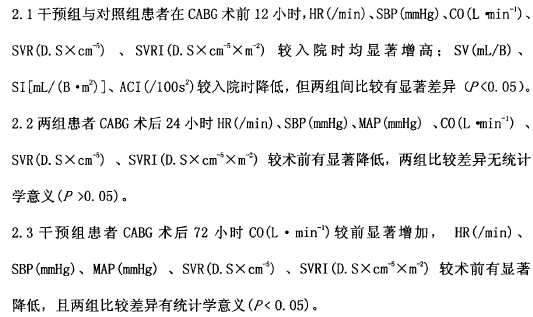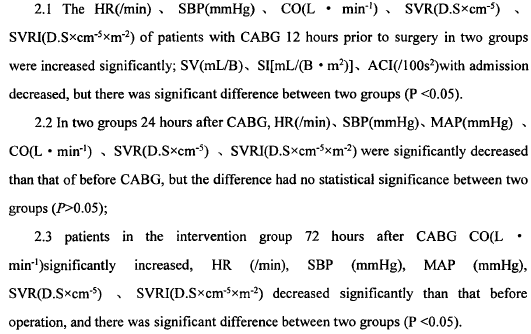中文摘要
目的 通过观察认知行为干预前后冠状动脉旁路移植术(CABG)患者焦虑、抑郁状态、术后导管留置时间、监护时间、住院时间的变化,探讨认知行为干预对CABG患者血流动力学和心脏功能恢复的影响,为完善CABG围手术期护理方案提供依据。
方法 本研究为病例对照研究,按照随机数字表法抽取2012年3月-2013年12月某三级医院心外科收治的冠心病并行CABG的患者66例,随机分为对照组(30例)和干预组(36例)。所有入选患者均无手术禁忌症。两组患者在性别、年龄、心功能分级和冠状动脉狭窄程度等方面比较,差别无统计学意义(P>0. 05),具有可比性。对照组给予常规护理,干预组在常规护理的基础上给予认知行为干预,包括认知疗法和行为疗法。比较2组患者入院后24小时、术前12小时、术后72小时焦虑、抑郁状态以及患者术后导管留置时间、监护时间和住院时间,采用美国BiozCom无创血流动力学监测仪测定不同时间段患者血流动力学相关指标,对两组患者术前及术后3天的心功能进行评价,分析认知行为干预对CABG患者焦虑、抑郁状态和术后心功能的影响。资料统计分析应用SPSS17. 0统计软件完成。计量资料以均数加减标准差(X±s)表示,采用t检验,计数资料率的比较采用x²检验。
结果
1.两组患者干预前后心理状态比较
1. 1对照组与干预组患者干预前SAS总分、SDS总分比较均无统计学意义;干预后干预组SAS、SDS总分均明显低于对照组,差异有统计学意义(P〈0. 05).
2.两组患者血流动力学指标比较

3.两组胸腔引流管、气管插管留置时间、ICU监护时间及住院天数比较
术后气管插管时间、ICU监护时间、平均住院天数明显少于对照组,两组有显着差异(P〈0. 05),胸腔引流管留置时间两组比较无显着差异(P>0. 05)。结论认知行为干预能改善CABG患者围手术期心理状况,有效降低手术患者因应激而引起的反射性心率、血压升高,降低焦虑、抑郁评分,同时能够稳定围手术期血流动力学,增加术后心排血量,促进术后康复,提高患者生活质量,值得在临床推广应用。
关键词 认知行为干预;冠状动脉旁路移植术;焦虑;抑郁;血流动力学
ABSTRACT
Objective
By observing the cognitive behavioral intervention before and after coronary arterybypass grafting (CABG) in patients with anxiety,depression, and postoperative catheterindwelling time, guardianship,hospitalization time, explore the cognitive behavioralintervention on hemodynamic and cardiac function recovery of patients with CABG,provide the basis for perfecting CABG preoperative nursing care plan.
Methods
This research for the case-control study. 66 cases of coronary heart disease parallelCABG patients admitted in cardiac surgery were recruited from A Third-levelFirst-class central Hospital heart surgical department from March,2012 to December,2013.They were randomly divided into the control group (30 cases) and the interventiongroup (36 cases)。 All patients were no operation contraindication. Comparing the twogroups in gender,age, grade of cardiac function and complications and so on,therewas no significant difference (P>0.05) with comparable. The control group was givenroutine nursing, the intervention group received cognitive behavioral intervention on thebasis of routine care, including cognitive therapy and behavior therapy. Compared 2groups of patients 24 hours after admission, 12h before surgery and 72 hours aftersurgery of anxiety, depression and postoperative indwelling time, ICU care andhospitalization time,hemodynamic parameters were measured daily using the UnitedStates Bioz Com noninvasive hemodynamic monitor, and then compared between twogroups a day before operation and 3 days after to evaluate cardiac function. Theinfluence of cognitive behavior intervention on patients' cardiac function with anxiety,depression after CABG was analyzed. Data analysis was completed using statisticalsoftware SPSS 17.0. Measurement data was displayed as mean士standard deviation (X士s),and analyzed using the / test,count data was analyzed using Chi-square (x1) test.
Results
1.Comparison of the psychological state of two groups of patients before and afterintervention.
1.1 The scores of SAS and SDS in the control group and the intervention groupbefore intervention were not statistically significant; after intervention, the scores ofSDS and SAS were significantly lower than those in the control group, the differencewas statistically significant (P<0.05).
2.Comparisonof hemodynamic parameters in two groups.

3.Comparison of chest tube drainage, tracheal intubation indwelling time, ICUmonitoring time and hospital days in two groups .
Postoperative intubation time, ICU monitoring time, the average hospital stay wassignificantly less than the control group, there was significant difference in two groups(P<0.05), thoracic drainage tube indwelling time of two groups had no significantdifference (P>0.05)。
Conclusions
Cognitive behavioral intervention can improve preoperative psychological status inpatients with CABG,effectively reduce the surgical patients caused by stress andreflective heart rate, blood pressure, reduce anxiety and depression scores, meanwhile itcan stabilize the hemodynamic, increase cardiac output, promote the postoperativerecovery, improve the quality of life of patients, is worthy of clinical application.
Key words: cognitive behavior intervention; coronary artery bypass grafting;anxiety; depression; hemodynamic
目录
中文摘要
英文摘要
前言
文献综述
资料与方法
结果
讨论
结论
参考文献
致谢
第1章引言随着我国经济水平的发展及人口老龄化的加速,老年患者髋关节骨关节炎及股骨颈骨折等髋关节疾病发病率较高,人工全髋关节置换术(TotalHipArthroplasty,THA)是目前最常用的治疗方案,已经被人们普遍接受。人工全髋关节置换术对严重病变的髋关...
研究一慢性心力衰竭患者自我护理能力及生活质量的调查分析1前言慢性心力衰竭患者由于反复住院,导致其生活质量普遍低,而影响生活质量的因素比较复杂。本研究对住院的CHF患者进行问卷调查,了解住院的CHF患者自我护理能力及生活质量现状,分析影响其...
第1章引言重症监护室(IntensiveCareUnit,ICU)是救治各种危重患者并对其进行24小时密切治疗的单元,拥有多种先进的治疗仪器及急救设备,拥有反应敏捷、专业技术全面、强应变能力等综合素质过硬的医护人员,为急危重症患者提供连续、科学的监测与护...
第六章结论本研究采用认知行为千预方式结合我院的实践经验对CABG手术患者进行综合护理干预,监测患者围手术期心理应激情况,采用美国生产的BiozCora无创血流动力学监测仪,定时测量血流动力学相关指标,分析认知行为干预对CABG患者心功能的影响,同时观察...
第5章讨论5.1重症监护室患者ICU综合征发生情况本研究共有效选取248例入住重症监护室接受治疗的患者,在ICU接受治疗期间有61例患者发生ICU综合征,发生率为24.6%.近年来,国内外学者报道的ICU综合征的发生率并不统一,没有确切的统计,但...
讨论1胆总管结石行ERCP取石术术后疼痛研究通过内镜微创技术如ERCP、EST及内镜取石术处理胆管结石特别是胆囊切除术后胆管残佘结石的方法得到大多数专家学者的认可并在国内外临床上广泛使用。ERCP在我国已经幵展近30年,成功率不断提高,但其带来的一系列并...
3结果3.1大学生健康素养基本情况3.1.1问卷发放及回收情况发放问卷1983份,回收问卷1867份,有效问卷1783份,回收率为94.2%,有效率为95.5%。见表3-1。3.1.2调查对象的人口学资料本次调查的对象中,男生750人,占42.1%,女生1033人,...
研究结果本研究干预前后观察人数分别为47、44人,失访原因为生产、休假等;干预前后调查HCW-HH知识问卷、HCW-HH感知问卷回收率均为.本部分对观察结果和问卷数据进行分析,现将研究结果汇报如下。一、研究对象基本信息本调研研究对象平均年龄为33.27.88岁...
研究结果1.干预前后病人一般情况比较在实施PDCDA前,选取2013年1月-3月在某三甲医院呼吸科住院且神志清醒能够配合做答的患者200人进行噪声管理调查问卷,其中男97人,女103人,年龄28-88岁,平均年龄45.24.01岁,C0PD45人,气胸10人,肺部感染62人,肺栓...
第1章绪论1.1相关概念1.1.1慢性肾脏病慢性肾脏病(chronickidneydisease,CKD)是由于各种原因引起的慢性肾脏结构和肾功能异常(肾脏损伤超过3个月),伴随或不伴肾小球滤过率(glomerularfiltrationrate,GFR)下降。表现为肾脏病理学检查异...